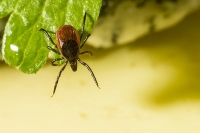Efficacy Of Micronutrients Against Lyme Disease
Lyme disease (LD), also called Borreliosis or Lyme borreliosis, is a bacterial infection transmitted by ticks. Statistics confirm that LD has become the most common vector-borne illness in the USA and Europe, although its occurrence has been documented on all continents except Antarctica.
LD is caused by the bacterium of genus Borrelia that is harbored in ticks. Borrelia can be found frequently in small and large mammals, and birds and reptiles on which many ticks feed and mate making them prone to become infected. The ticks that spread LD can sometimes co-transmit other tick-borne pathogens such as Ehrlichia sp., Babesia sp., and Bartonella sp.
LD is diagnosed based on the symptoms described by a patient, such as flu-like symptoms (including fever, headache, and fatigue), physical signs (e.g., rash and swollen areas on the body), and the results of laboratory testing. Because the symptoms of LD can be diverse and mimic other diseases, and since the laboratory tests are still not 100% reliable, the diagnosis and treatment quite often represent a challenge for clinicians. It is commonly perceived that treatment with appropriate antibiotics assures successful recovery. In reality, LD treatment still faces many challenges as the rate of disease progression and the response of the patient to treatment may vary due to individual predispositions, immune system efficacy, and the very effective survival/adaptive strategies of Borrelia sp. (we addressed this aspect in our previous newsletter).
In a continuous search for effective therapy for LD patients the use of natural, non-toxic treatment still remains an unexplored area. At the Dr. Rath Research Institute we used our pioneering approach of micronutrient synergy in our strategy to find synergistically working natural substances (vitamins and phytochemicals) which could simultaneously target the causes of LD (Borrelia sp.) and restore healthy functions of the body affected by infection (inflammation and body biomarkers).
We tested the efficacy of 45 natural occurring phytobiologicals against two species of Borrelia: Borrelia burgdorferi sensu stricto (the pathogen causing Lyme disease in the USA) and Borrelia garinii (the pathogen causing Lyme disease in Europe). In the tests we included all morphological stages of Borrelia (active forms, i.e., spirochetes, and latent forms, i.e., rounded bodies and biofilm). We combined the most effective compounds into one patented formula which displays higher effectiveness than its individual components against Borrelia and the success of this approach opens up new possibilities for safe and effective control of LD, bringing hope for millions of LD patients.
